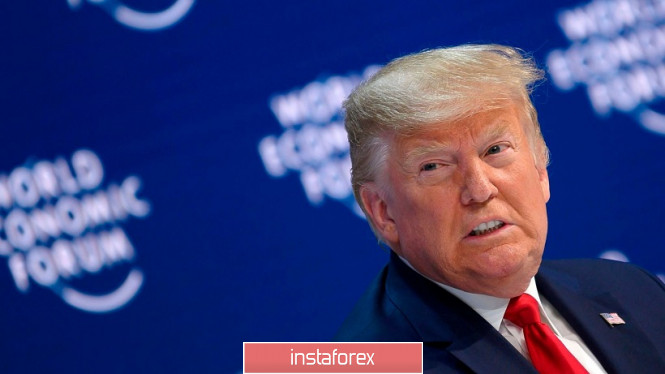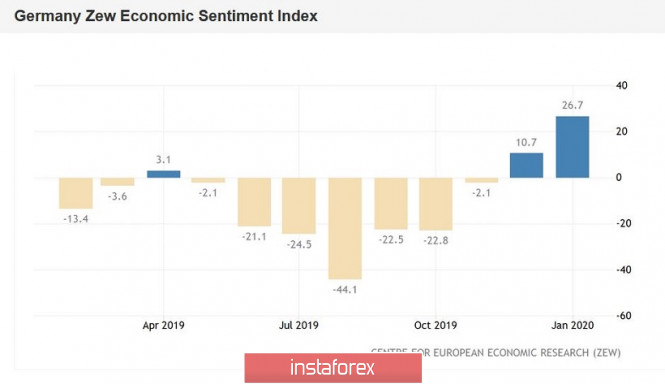The euro-dollar pair made another attempt at corrective growth yesterday, rising to the area of the 11th figure. Magnificent reports from the ZEW Institute allowed buyers to spread their wings, thereby lowering the downward impulse. However, the fundamental picture for the pair changed dramatically in the afternoon of Tuesday, and bearish sentiment began to prevail again.
Blame it all to Donald Trump, who switched from China to the European Union in the context of trade claims. Due to this, the optimistic mood in the market instantly worn out, and the pair EUR/USD, in turn, returned to its previous position. At the moment, the situation is frozen in the air, as traders do not dare to open large positions in anticipation of the ECB January meeting. The growth of key macro indicators in the eurozone does not allow us to play against the euro with confidence, so the "on-duty" threats of the US president could not provoke a large-scale decline in the price of EUR/USD. In other words, the pair is now at a crossroads - either the bears will lead it to the region of the 9th figure, or the bulls will be able to return the single currency to the region of 11-12 figures.

Let's start with the positive (for the euro) news. ZEW Institute business sentiment indices came out in the green zone, although preliminary forecasts were also very optimistic. But real numbers exceeded forecasts. In addition, positive dynamics were recorded both in Germany and in the whole Eurozone. The German index came out of the negative area (for the first time since May last year), reaching 10.7 points last month. In January, it rose to 26.7 points with a forecast of growth of up to 15 points. Likewise, the pan-European indicator left the territory of negative values in December, rising to 11 points. The January index rose to 25.6 points (with a forecast of growth to 16.3 points). This dynamics is primarily due to a pause in the trade war between the United States and China. The slowdown in the Chinese and global economies negatively affected the German economy in particular, and the entire eurozone as a whole. Moreover, the German economy was able to avoid a recession, but, the negative scenario would most likely come true if the trade conflict escalated further.
However, traders are now worried about another problem. For two years, a trade conflict has been smoldering between the US and the EU, which could well develop into a full-scale trade war. The fact is that Donald Trump returned to the agenda the issue of introducing duties on European cars and spare parts again. This "Damocles Sword" hangs over Europe for a long time, since the year before last. The automotive industry not only in Germany, but also in France and Italy is under attack - according to preliminary estimates, the total cost of the indicated duties is $ 300 billion. According to experts, the "domino effect" will follow in the case of the introduction of US duties: the business climate in the eurozone countries will again deteriorate significantly, thereby slowing down the growth of key indicators and the economy as a whole.
Let me remind you that, Jean-Claude Juncker, who then headed the European Commission, prevented the onset of a trade war during the summer of 2018 - during his visit to the States, he agreed with Trump to create a working group to resolve the problem. At the beginning of last year, Trump announced again that he was ready to introduce 20 percent duties on cars and auto parts imported from EU countries if the EU does not reduce or eliminate trade barriers against US companies. However, after weeks of deliberation, the American president postponed the matter. Meanwhile, China played an important role in this - another escalation of the trade war in the summer of 2019 turned the attention of the White House to Beijing.
However, the problem itself did not go away, and the US president reminded the financial world of this, putting pressure on the European currency. In an interview with The Wall Street Journal, he announced his "serious intentions" to impose duties on car imports from the EU if the parties fail to conclude a trade agreement - moreover, under the conditions "which Washington is satisfied with." It is noteworthy that Trump did not talk about the "deadline this time. According to him, "Europeans themselves know what the deadline is set." This nuance has caused even greater concern in the market, due to growing uncertainty.
Thus, Donald Trump threatened Brussels to open another "front" of the trade war again. The open question is whether his threats are real or not. Opinions of experts on this subject vary. According to some analysts, the US president will not resort to real action (although it may increase verbal pressure) until the end of the election and the final end of the US-Chinese conflict. After all, Brussels will impose retaliatory duties on American goods in this case, for a total amount of 20 to 40 billion euros. Nevertheless, other experts admit this scenario, given the EU's quite tough position on this issue.

All this suggests that the European currency will be under pressure, although the attention of traders of the EUR/USD pair will switch to the ECB meeting in January tomorrow. The topic of possible fees will directly affect the euro only if Donald Trump reiterates his threats. From a technical point of view, the pair is located in the Kumo cloud (on the daily chart) and between the middle and lower lines of the Bollinger Bands indicator. The support level is at 1.1050 (the lower line of Bollinger Bands), while the resistance level is 1.1140 (the middle line of this indicator). At the moment, the vector of price movement depends on the outcome of tomorrow's meeting of the European Central Bank.
The material has been provided by InstaForex Company - www.instaforex.com